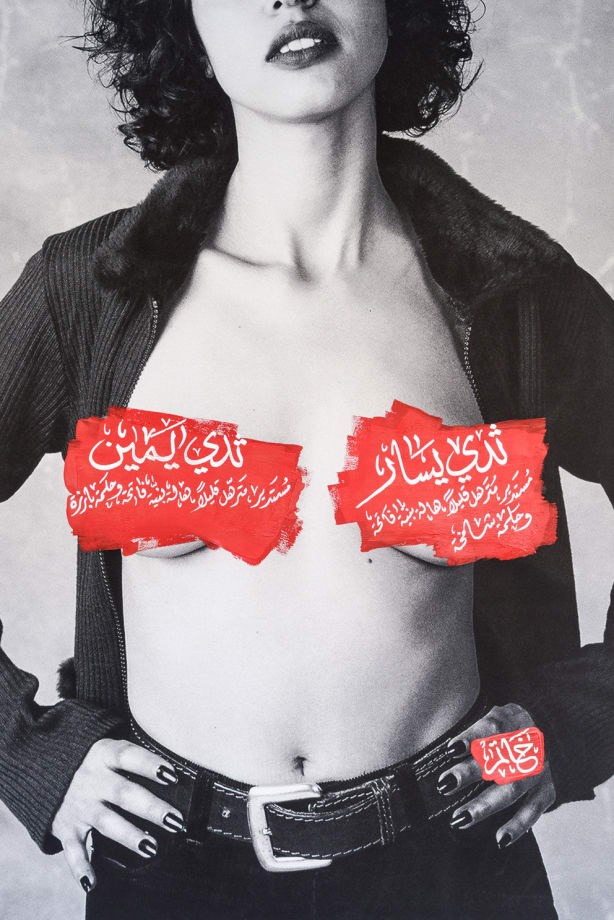Ayyam Gallery Beirut is pleased to present The Naked Truth, the solo exhibition of Ammar Abd Rabbo. Debuting a new body of work by the artist, the exhibition features mixed-media photographic works that explore the concept of censorship in the Arab world as it is applied to the naked body and affirmations of sexuality. Invoking the blacked-out imagery of print, billboard, and other forms of censored media, Abd Rabbo combines original photographs with overlaid text and painted areas that conceal the ‘risqué’ details of nude portraits.
The series contains photographs that were taken by Abd Rabbo over a several year period. Some of the included photographs resulted from his work as a photojournalist while others were taken with various models during individual sessions. Inspired by an advertisement for Lucas Cranach’s The Three Graces (1531) that was later censored according to regulated codes of ‘decency’ when reproduced in an Arab publication, Abd Rabbo paints over the ‘offending’ parts of his figures, the basic anatomical details that identify his or her sex. Part of the motivation for the series came from the artist’s frustration with the double standards of this form of restriction in regional visual culture. As an active photojournalist who has worked with international photo agencies and major media outlets, he encounters a steady stream of documented violence, the graphic nature of which is rarely limited by publications or state authorities.
Working closely with classically trained Syrian calligrapher Aqeel, Abd Rabbo conceals the taboo details of his images but then describes the hidden body parts with the sterile language of medical terminology or the witty descriptions that appear in the fifteenth-century Arabic-language book The Perfumed Garden of Sensual Delight, a well-known, although seemingly forgotten, example of erotic literature from Tunisia. Intended as a sex manual that addresses everything from sexual health to interpretations of dreams, the book was written by a Muslim spiritual leader and scholar who sought to educate his community, often citing religious texts.
In Abd Rabbo’s works, the blacked-out areas and ornamental, hand-painted descriptions remind the viewer of the cultural history of sexuality in the Arab world. His incorporation of calligraphy urges the viewer to make this association, as the written art form is revered as one of the region’s greatest traditions and has been used to record the sensual imagery of some of its most revered poets. At the same time, the artist appeals to the sensibilities of the present day with constructed imagery, frequently referencing fashion photography, a genre he is familiar with from his coverage of high profile events as a photojournalist.
The artistic and documentary worlds are merged as Abd Rabbo summons the spirits of acclaimed image-makers such as Robert Mapplethorpe, whose iconic confrontational approach to photography questioned the limits of representation and the boundaries between art and life and public and private spaces.
About the Artist
As one of the Arab world’s prominent photojournalists, Ammar Abd Rabbo’s work has been published in leading and widely circulated publications, from Time Magazine to Paris Match, Der Spiegel, Le Monde, and Asharq Al Awsat, where he signed more than sixty magazine covers. Spanning a twenty-year career, Abd Rabbo’s portfolio includes war coverage in Iraq, Lebanon, Libya, and Syria; portraits of heads of states; world-renowned celebrities such as Michael Jackson; as well as high profile events such as the Cannes Film Festival and Paris Fashion Week.
Born in Damascus in 1966, Abd Rabbo lived in Libya and Lebanon before moving to France in 1978 after the intensification of the Lebanese Civil War. Prior to joining Sipa press agency in 1992, he studied political science at the Institut d'Etudes Politiques. He later left Sipa to create Balkis photo agency, which is now syndicated by Abaca Press. His works are housed in the Barjeel Foundation, Sharjah; Daniel Barenboim Collection, Berlin; Salsali Private Museum; and The Samawi Collection, Dubai. Abd Rabbo has recently participated in collective exhibitions at Bansky’s Dismaland, Weston-super-mare, England (2015); Imago Mundi at Benetton Foundation, Venice Biennale (2015); BOX Freiraum gallery, Berlin (2015); Institute du Monde Arabe, Paris (2014); The Milan Triennale (2014); MAXXI Museum, Rome (2013). His work has been highlighted in solo shows at Europia gallery, Paris (2014) and Ayyam Gallery Beirut and Dubai, DIFC (2012; 2012).

